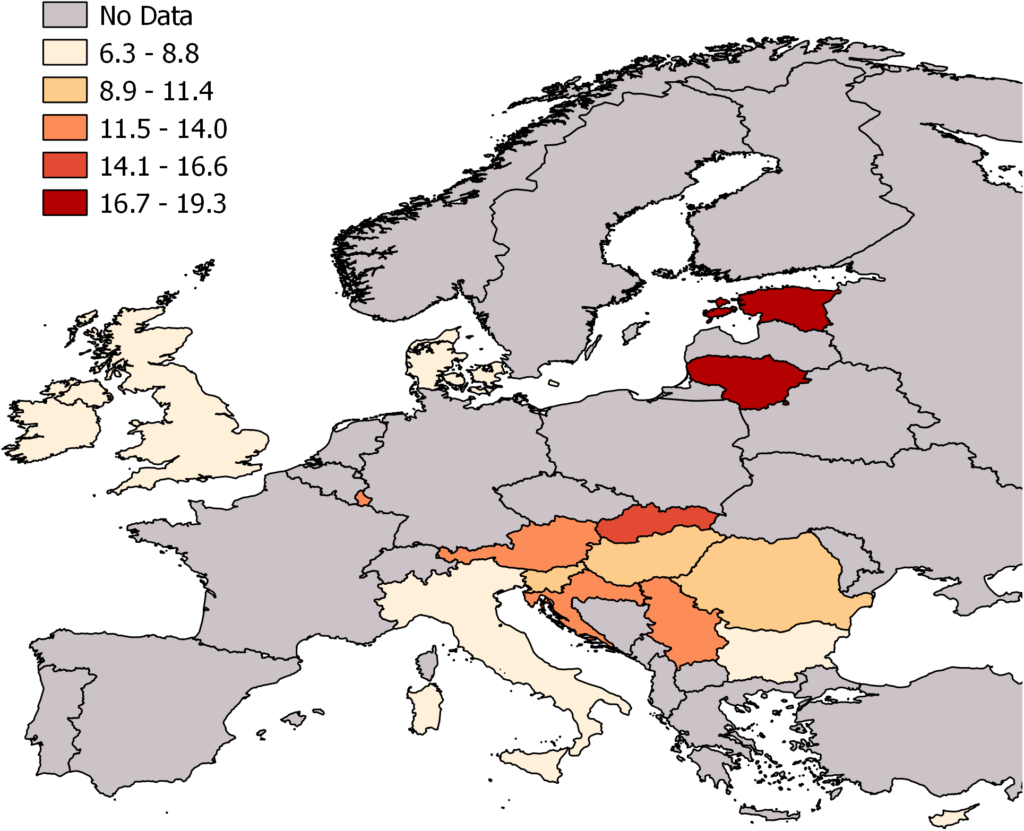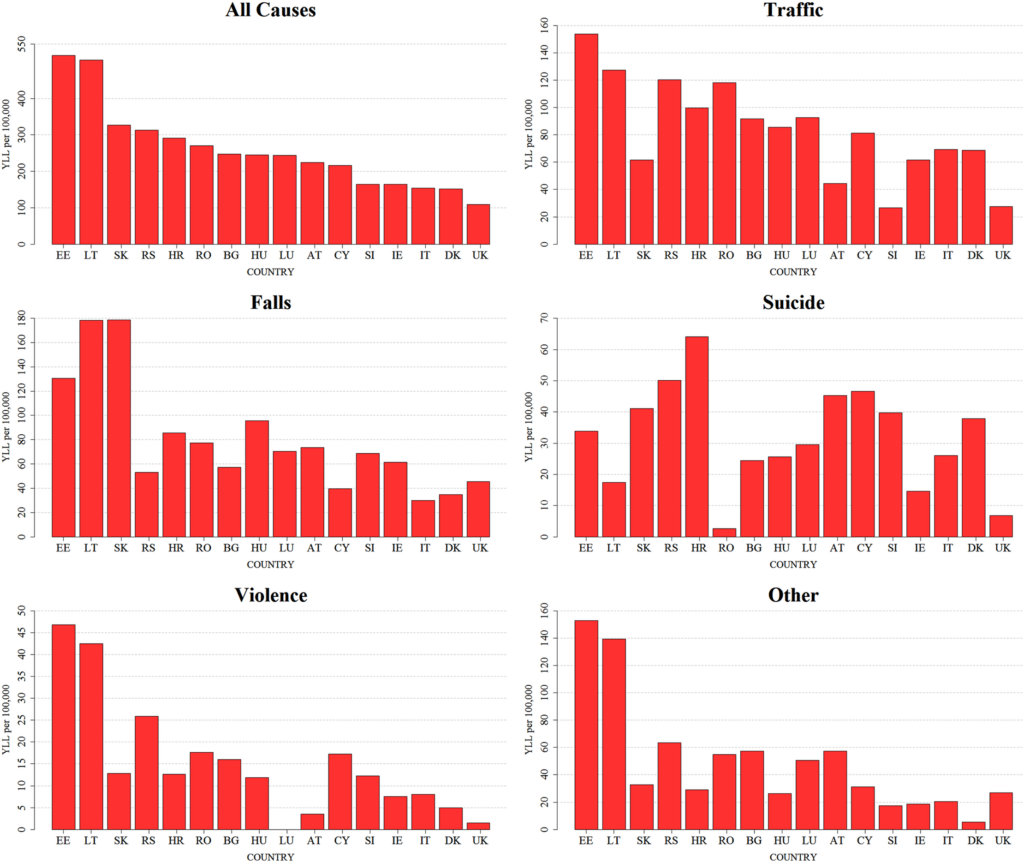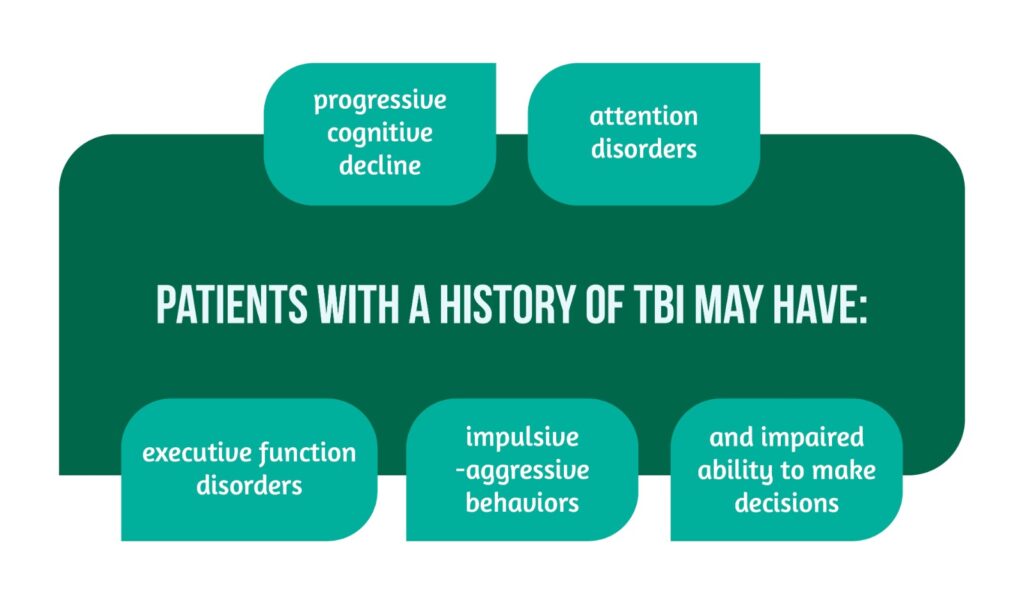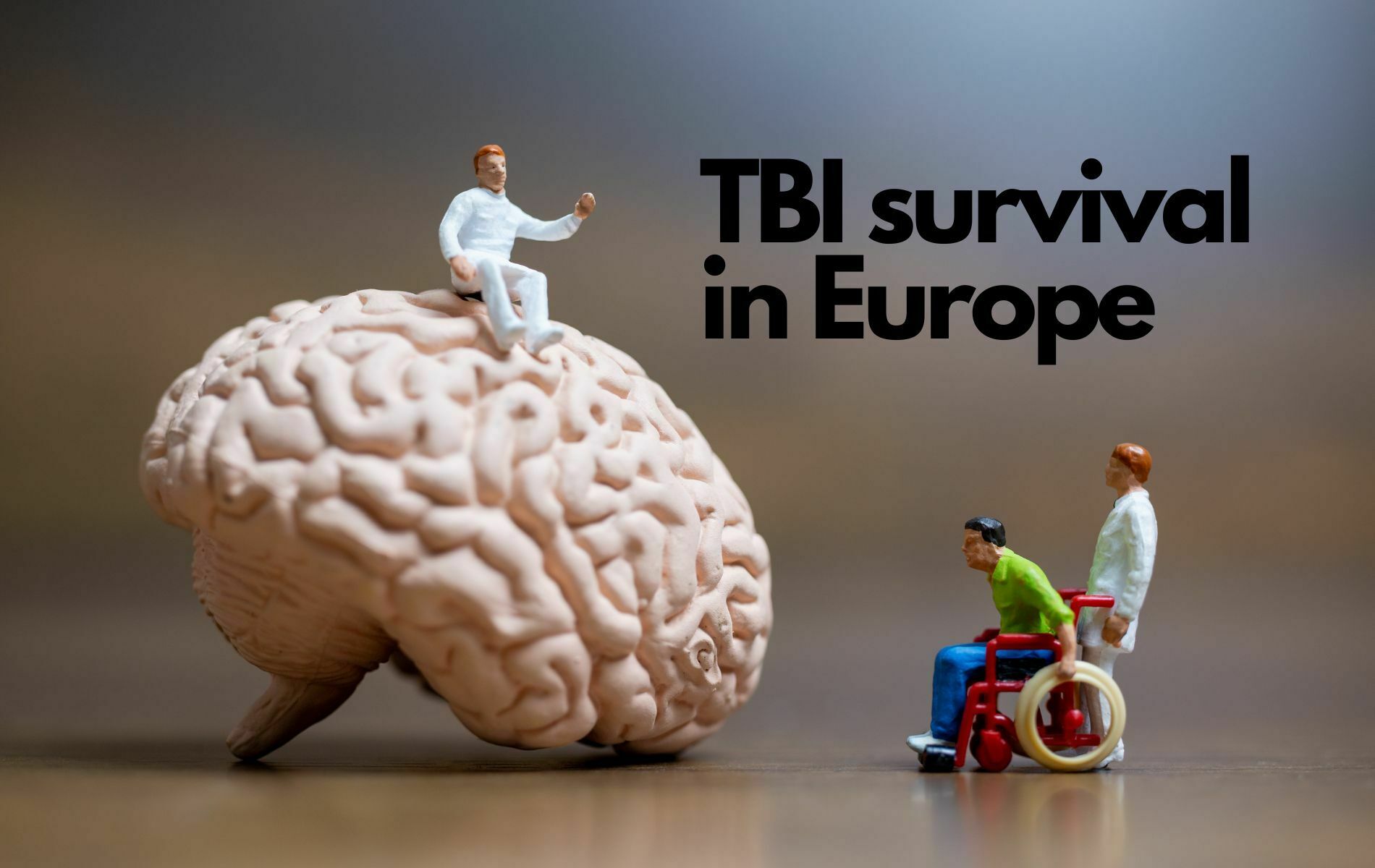Keywords: TBI, YLL, TBI epidemiology, TBI prevention
Introduction | TBI survival in Europe
Traumatic brain injury (TBI) represents a major problem all over the world that has unpleasant consequences both for the patient and society. The incidence of TBI remains high in many low- and middle-income European countries due to the increase in the number of road accidents in the absence of appropriate traffic safety regulations. In high-income countries, TBI incidence due to road traffic incidents is decreasing, but the elderly remain the vulnerable population due to the increased risk of falls.
Healthcare costs are high for society because TBI patients have multiple traumas that need to be treated, and they need long-term treatments for the complications of TBI. In addition to drug treatment, patients need access to physical, speech, and occupational rehabilitation to regain partial independence [1]. In the European Union, there is a high prevalence of disability in TBI survivors [2] (Figure 1).

In a study conducted by Majdan et al. in 2016, it was pinpointed that TBI reduces life expectancy in patients with a history of brain injury. In the European Union, there are approximately 1.5 million TBI-related hospital admissions and 57,000 TBI-related deaths yearly. The mortality rate reported to 100,000 people is 11,7 (95% CI: 9.9 to 13.6), and the hospital admissions rate is 287,2 (95% CI: 232.9 to 341.5). It is estimated that the life expectancy of patients with traumatic brain injury varies between less than 45% and 85% of people without a history of TBI, depending on the severity of the trauma and the functional status of the patient [1].
Multiple studies try to quantify the full extent of TBI cases in the target population and the impact on society and the health system. Still, often the necessary data are insufficient to assess the real impact of the problem. The Global Burden of Disease Study wants to evaluate the mortality and morbidity rates and compare the impact on public health for each disease category, adapted to the target population.
For a better understanding of the problem, specific measurement units were introduced, such as years of life lost (YLLs), years lived with disability (YLDs), and disability-adjusted life years (DALYs).
-> YLLs quantify the number of years lost because the patient dies earlier due to health problems.
-> YLDs quantify the years lived with the disease.
-> DALYs represent the sum of years of life lost and years lived with disability.
The lack of data on the population with TBI is a limitation of the use of measurement units in other countries [1].
Data collection
The aim of the research of Majdan was to evaluate the YLLs TBI in European countries. This study used data collected by the statistical office of the European Union (Eurostat), from death certificates, in 2013 from 16 countries in Europe (Austria, Bulgaria, Croatia, Cyprus, Denmark, Estonia, Hungary, Ireland, Italy, Lithuania, Luxembourg, Romania, Serbia, Slovakia, Slovenia, and the United Kingdom). The other countries were excluded because of the insufficient data about causes of death (external cause of death, specific nature of injury) and other details in people with previous TBI (age of death, sex). The findings of the research were extended to all European Union countries [1].
In order to include only patients whose death occurred as a result of traumatic brain injury, a universal definition was created. TBI-related death is defined as ‘ a death where the cause of death was a TBI or a TBI sequela, i.e., from the provided database, records in which the nature of the injury was coded as ICD-10 S00±S09 (injuries to the head) or T90 (sequelae of injuries to the head)’ [1].
The results of this study were extended to the 28 countries of the European Union countries [1].
Research results
From the data, it appears that in 2013 there were a total of 17,049 deaths due to TBI in the 16 countries where the data were collected. This number translates to a rate of 11,3 TBI-related deaths per 100,000 persons per year. 70% of deaths occurred among men, with a peak in the 35-84 age group (72% of deaths in this age group). In females, most deaths occurred in 65 years old and older group (73% of deaths). Death rates in the countries included in the study are shown in Figure 2 [1].

In Lithuania, it was observed the highest death rates due to TBI, both in general and among men. In Austria, it was observed that the highest death rates are among females. The study emphasizes that countries such as Estonia and Bulgaria identified the largest sex differences in TBI rates (male-to-female ratio of 5,8 in Estonia and 4,5 in Bulgaria) [1].
The study mentions that in the 16 countries included where the data were collected, 374,636 years of life were lost (YLLs) due to TBI. Most of the YLLs (76%) were in the male population. The group most exposed to TBI and contributing the most to the number of YLLs is made up of people aged between 15 and 64. They caused 73% of all years of life lost due to traumatic brain injury. It was found that the sum of the YLLs due to TBI increases directly proportional to the number of inhabitants of each country, due to the increase in the population at risk [1].
In order to better describe the problem of early death due to TBI, it was estimated that the average value of YLLs for a death TBI-related is 24.3 years, 25,6 YLLs in the male population and 20,9 in the female population. The number of years lost for each patient decreases with increasing age, obtaining a number of 3.4 years lost in people aged 85 years and older, while in the age group 0-4 years, an estimated YLLs of 79,4 [1].
The most common causes of YLLs TBI across the countries included in the research were traffic injuries and falls, followed by suicide and violence (Figure 3). Non-traumatic causes of death (natural forces, intoxication, and others) were excluded, and a total number of 991,420 years of life lost due to TBI was reached, out of which 714,757 (72%) were men [1].

Discussion
The research conducted by Majdan M. includes 16 European countries. A total number of 17,049 TBI-related deaths were identified in 2013. 374,636 years of life were lost (YLLs) due to TBI-related deaths. The males were more exposed to the risk of trauma, contributing to 76% of all TBI YLLs.
Falls and traffic injuries were the most common causes of traumatic brain injury. It is estimated that each TBI death was associated with 24.3 years of life lost. The number of YLLs is higher among men (25.6 YLLs), in contrast to women (20.9 YLL). By expanding the results of the current research of the 28 countries in the European Union, an estimated number of 1.3 million traumatic brain injuries occurred in 2013, with 1.1 million cases in males and 270,000 in females [1].
A study conducted by Scholten CA in 2014 showed that in the Netherlands, TBI caused the loss of 118,207 years of life annually between 2010 and 2012. Also, the males were more exposed to the risk of TBI and were responsible for 59% of cases of TBI [3].
In a patient with TBI, it is important to evaluate the Glasgow Coma Score (GCS) and determine the severity of the brain injury (mild, moderate, or severe). Such categories are useful for predicting long-term outcomes in patients with TBI [4]. However, this classification is not sufficient to establish the prognosis of the disease, and the series of investigations must be completed with neurocognitive testing, EEG, evoked responses, blood biomarkers, and both CT and MRI scans [2]. Patients with mild TBI and normal CT scans may have abnormalities on subacute MRI, which are associated with poor neurocognitive and neuropsychiatric outcomes [2]. The mortality rate is increased among patients with severe forms of TBI (30-40% deaths in observational studies) [5].
The epidemiology of TBI is constantly changing. In high-income countries, patients with TBI are more frequent motor-vehicle occupants, unlike low- and middle-income countries low-income countries where cases of TBI occur more frequently in people who travel on foot, cyclists, and motorcyclists. In high-income countries, traffic safety regulations led to a decline in traffic incidents. Alcohol consumption is another important risk factor for traumatic brain injury [2,5].
Primary prevention is a very important step in reducing the number of TBIs. Prevention strategies must be adapted to each country, depending on the causes of trauma and the population at risk. TBI caused by road accidents can be avoided by using a seat belt in the motor vehicle, avoiding the consumption of alcohol or drugs, and using a helmet when riding a bicycle or motorcycle.
The elderly have an increased risk of falls, and they should regularly go to the ophthalmologist for re-evaluation, and their medication should be reviewed by the doctor. Also, their home should be properly lit because of the increased risk of falling due to tripping over objects. Pediatric TBI can be avoided by using age and size-appropriate car seats and seat belts and by installing window guards and safety gates at the top and the bottom of the stairs to prevent incidents [6].
TBI is a risk factor for multiple neuropsychiatric diseases such as:
- epilepsy
- stroke
- Alzheimer’s dementia
- parkinsonism
- depression.
Repetitive mild traumatic brain injury can lead to a neurodegenerative pathology called chronic traumatic encephalopathy (CTE). Also, patients with a history of TBI may have a set of affections (Figure 4).

For these reasons, they have problems in social and vocational reintegration, requiring integration in a rehabilitation center [2,5,7].
Conclusions and Future Directions | TBI survival in Europe
Traumatic brain injury remains an extremely important problem worldwide due to the increasing number of victims despite the legislative measures taken by each country and the long-term complications that involve huge costs for society. TBI can be considered a ‘silent epidemic’ because of the lack of information about the real number of victims and the deficient monitoring of cases. The results of the study of Majdan et al. can form a basis for future research on the burden of TBI in the world. In order to follow the changes in the epidemiology of TBI and identify the groups at risk, standardized epidemiological studies should be carried out with the inclusion of all age categories [1,2].
It is important to create prevention programs on several communication channels to teach the population how to prevent TBI. Moreover, the road infrastructure should be improved, and legislative measures must be taken. All preventive measures must be adapted to the population at risk and to the living conditions of each country. The result of these measures should be evaluated annually by comparing the statistics of current TBI cases with those of previous years [1,2,5].
Currently, there is increased interest in understanding the mechanism of the appearance of neurodegenerative pathology and the accentuation of cognitive decline. Some studies explain these pathologies by emphasizing the production and storage of beta-amyloid in the brain, but extensive research is needed to be able to predict the risk of dementia based on biomarkers and to understand the triggering mechanism of neurodegenerative pathologies [2,7].
For more information about TBI, visit:
For more information about the impact of TBI visit:
- Assessment of Quality of Life after TBI using QOLIBRI-OS
- Can TBI affect taste and smell?
- Mild TBI outcomes – lesssons from the CENTER-TBI study,
We kindly invite you to browse our Interview category https://brain-amn.org/category/interviews/. You will surely find a cluster of informative discussions with different specialists in the field of neurotrauma.
Bibliography
- Majdan M, Plancikova D, Maas A, Polinder S, Feigin V, Theadom A, et al. Years of life lost due to traumatic brain injury in Europe: A cross-sectional analysis of 16 countries. PLoS Med. 2017; 14(7):e1002331; doi:10.1371/journal.pmed.1002331
- Roozenbeek B, Maas AIR, Menon DK. Changing patterns in the epidemiology of traumatic brain injury. Nat Rev Neurol. 2013; 9(4):231–6; doi:10.1038/nrneurol.2013.22
- Scholten AC, Haagsma JA, Panneman MJM, van Beeck EF, Polinder S. Traumatic Brain Injury in the Netherlands: Incidence, Costs and Disability-Adjusted Life Years. Mohapatra S, editor. PLoS ONE. 2014;9(10):e110905; doi: 10.1371/journal.pone.0110905
- Brazinova A, Rehorcikova V, Taylor MS, Buckova V, Majdan M, Psota M, et al. Epidemiology of Traumatic Brain Injury in Europe: A Living Systematic Review. Journal of Neurotrauma 2021; 38(10):1411–40; doi: 10.1089/neu.2015.4126
- Maas AIR, Menon DK, Adelson PD, Andelic N, Bell MJ, Belli A, et al. Traumatic Brain Injury: Integrated Approaches to Improve Prevention, Clinical Care, and Research. The Lancet Neurology 2017; 16(12):987–1048; doi: 10.1016/S1474-4422(17)30371-X
- Prevention | Concussion | Traumatic Brain Injury | Cdc Injury Center; 2021; Available from: https://www.cdc.gov/traumaticbraininjury/prevention.html
- Mendez MF. What is the Relationship of Traumatic Brain Injury to Dementia? JAD. 2017; 57(3):667–81; doi: 10.3233/JAD-161002




